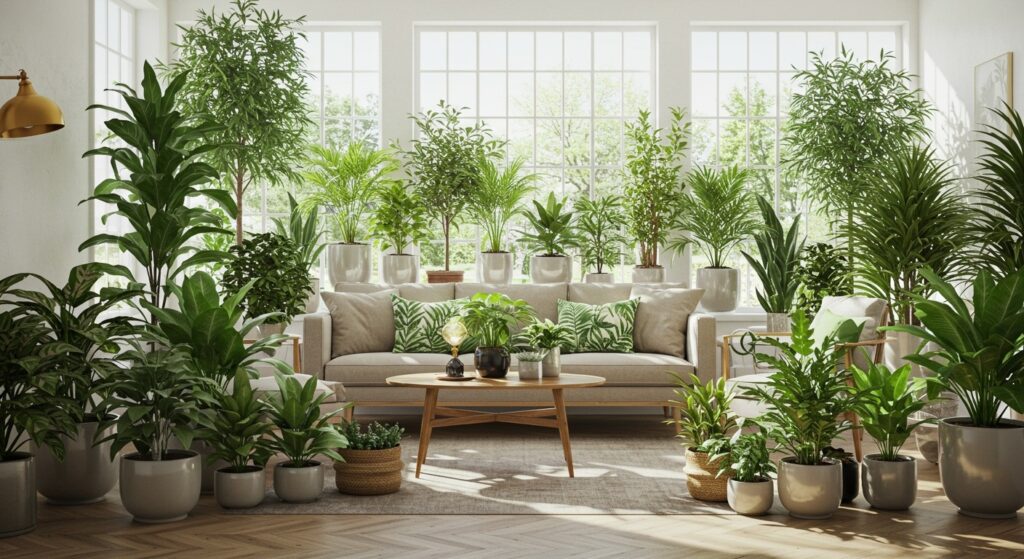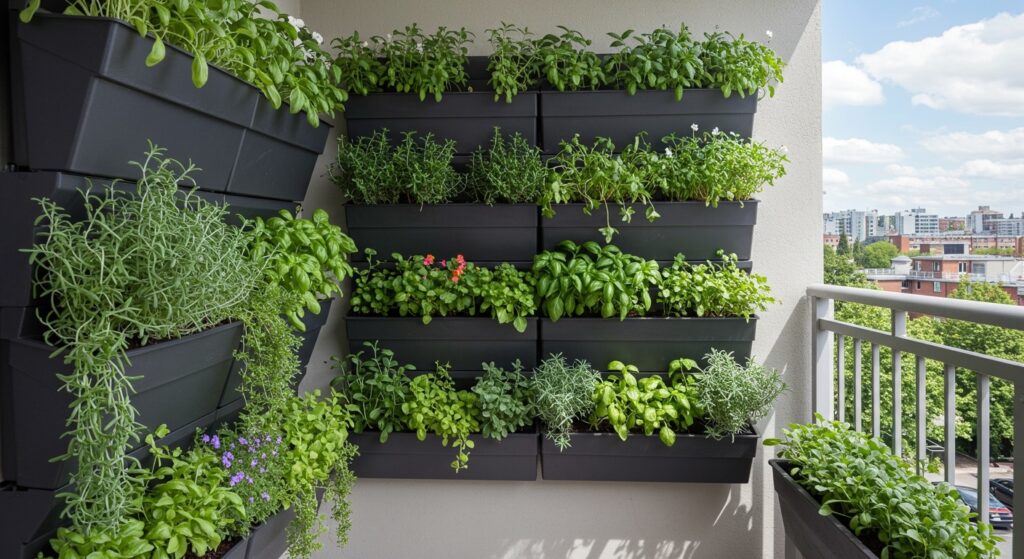You’ve been staring at that blank wall on your balcony for months. Maybe it’s the bare fence in your backyard or that narrow strip beside your patio that’s too slim for pots. There’s potential there, but horizontal space? Non-existent.
That’s where vertical gardening changes everything. Instead of spreading out, you grow up – using walls, fences, and hanging structures to create layers of greenery. It’s not just a space-saving trick. It’s how you transform tight corners into thriving gardens that actually feel abundant.
Whether you’re working with a tiny balcony, a cramped urban patio, or just want to maximize every inch of your yard, these vertical gardening ideas will show you how to pack serious plant power into the smallest spaces. No massive yard required.
1. Wall-Mounted Pocket Planters for Herb Gardens
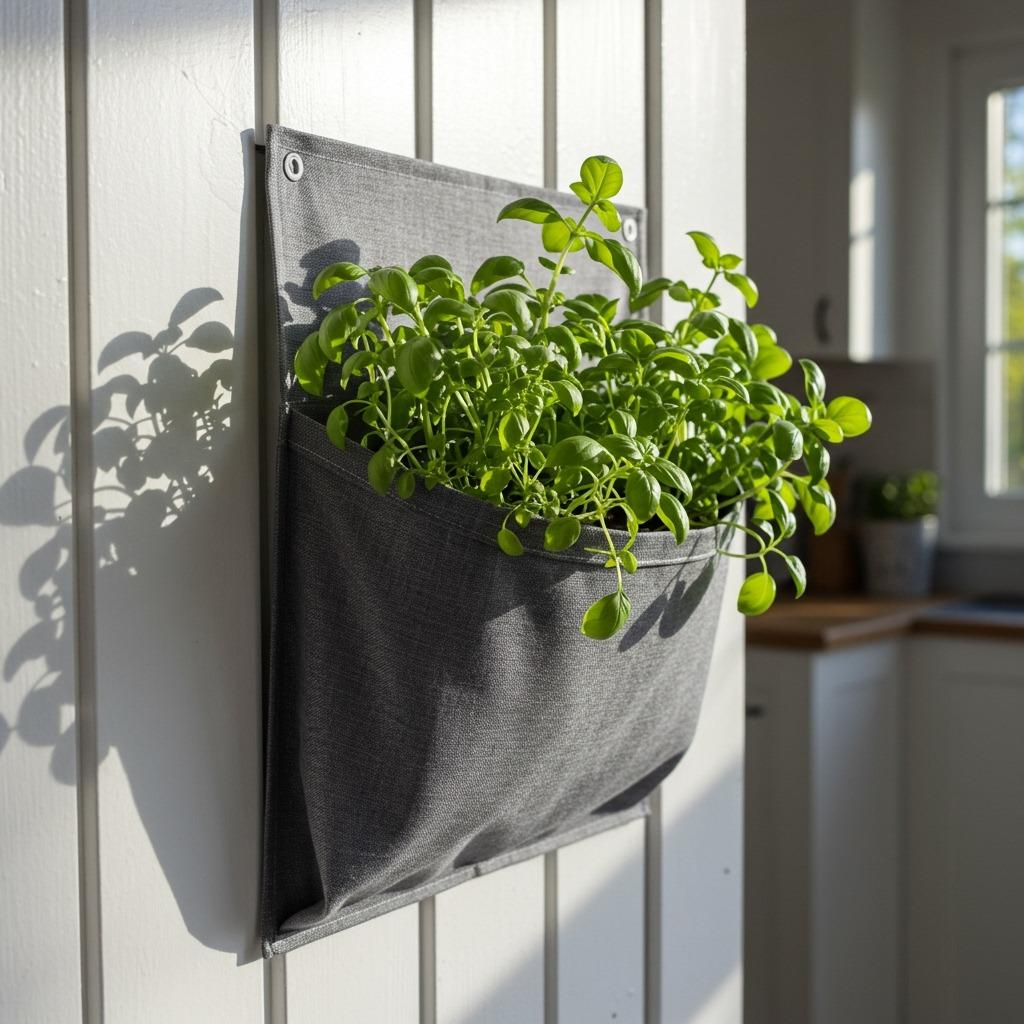
Those fabric pocket planters you see on Pinterest? They actually work remarkably well for herbs. The vertical pockets create individual growing spaces, and herbs don’t need deep roots, so they thrive in these setups.
Hang one on a sunny wall near your kitchen door. Fill it with basil, cilantro, parsley, and thyme. You’ll have fresh herbs within arm’s reach, and the cascading greenery looks intentional, not cluttered.
The best part? These planters are forgiving. If one pocket gets overwatered or a plant fails, it doesn’t affect the others. Start with easy-growers like mint and oregano while you figure out your watering rhythm.
2. Ladder Shelves Turned Plant Display
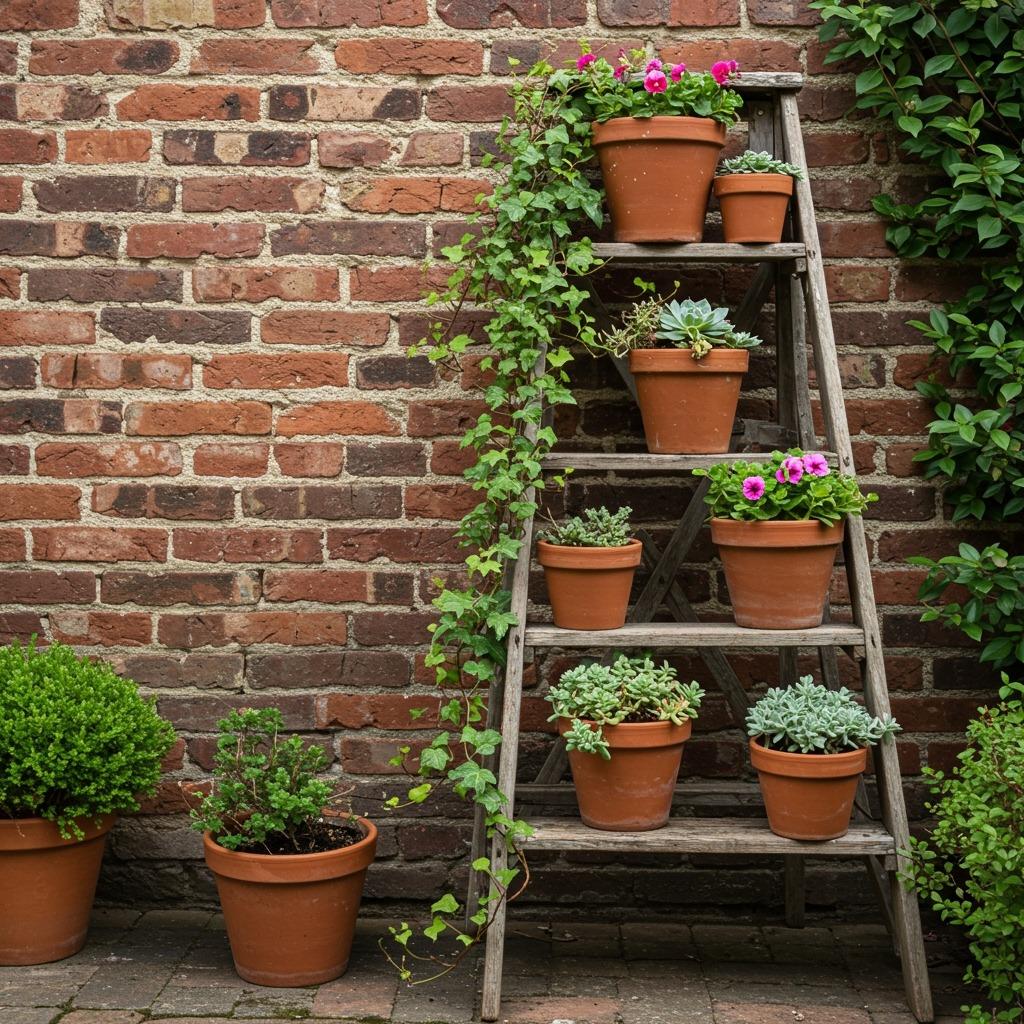
Old wooden ladders make surprisingly elegant plant stands. Lean one against a wall or fence, and suddenly you have multiple tiers for pots without taking up floor space.
Paint it white for a cottage feel, or leave it weathered for rustic charm. Place larger pots on lower rungs where they’re stable, and cluster smaller plants toward the top. This creates visual weight at the bottom while keeping things airy above.
This setup works beautifully for renters too. Nothing’s permanently installed, so you can rearrange or take it with you. Just make sure the ladder is secure – use wall anchors if needed, especially in windy areas.
3. Hanging Gutter Gardens Along Fences

Repurposed rain gutters mounted horizontally create linear planters perfect for shallow-rooted crops. Strawberries, lettuce, and small flowers all do well in these narrow channels.
Mount them in rows along a fence, staggered at different heights for a dynamic look. Drill drainage holes every six inches to prevent waterlogging. The long, continuous planting space is ideal for growing salad greens you can harvest in succession.
This is one of those DIY home renovation ideas that costs almost nothing if you source used materials. Check construction sites or home improvement stores for leftover gutter sections. A simple brackets-and-screws installation gives you an instant garden wall.
4. Trellis Panels with Climbing Vegetables
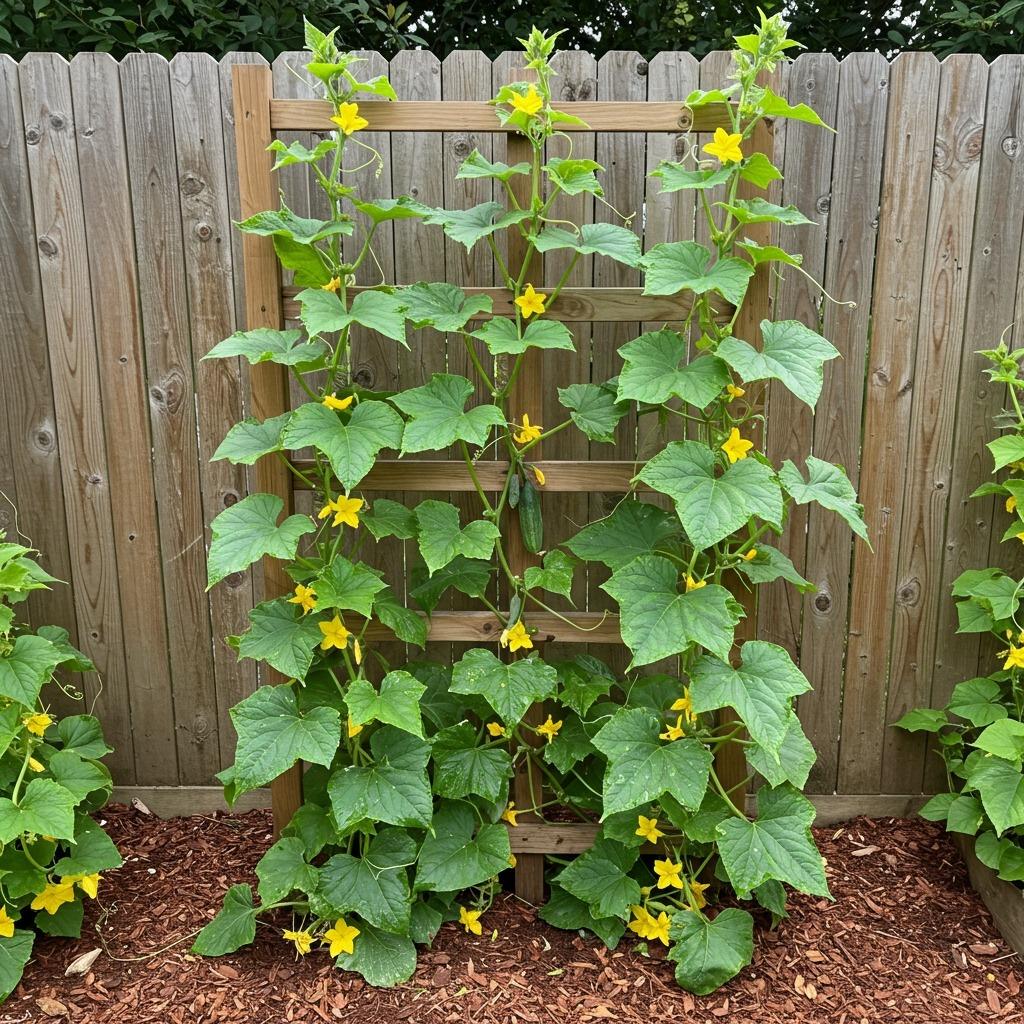
Vertical trellises aren’t just decorative – they’re productivity powerhouses for vining vegetables. Cucumbers, beans, peas, and even small melons will climb upward when given support, freeing up valuable ground space.
Install a sturdy trellis panel against a wall or fence in your sunniest spot. As plants grow, gently guide their tendrils onto the structure. You’ll end up with a living green wall that produces food all season.
The vertical growth also improves air circulation around plants, reducing disease problems common in crowded gardens. Plus, harvesting is easier when everything’s at eye level instead of hidden beneath leaves on the ground.
5. Tiered Plant Stands for Balcony Corners

Those corner spaces on balconies are often wasted. A tiered corner plant stand changes that immediately, giving you three or four levels of planting space in a compact footprint.
Choose stands with varying platform sizes – larger on bottom, smaller on top. This creates visual interest and accommodates different pot sizes. Fill it with a mix of flowering annuals, herbs, and trailing plants that spill over the edges.
For small balconies, this is one of the smartest balcony vertical gardens you can create. It maximizes vertical space without blocking your floor area, so you still have room to actually use your balcony.
6. Living Wall Panels with Built-In Irrigation

Living wall systems sound complicated, but modular panels with built-in reservoirs make them surprisingly manageable. These panels lock together and often include drip irrigation that waters all plants evenly.
Installation takes an afternoon – mount the frame, clip in the planted panels, connect a water source. You can grow everything from ferns and succulents to edible greens, depending on your light conditions.
The initial investment is higher than other options, but the payoff is substantial. These systems are designed for longevity and create that lush, professional look you see in trendy cafes. If you’re serious about vertical gardening, this is the upgrade worth considering.
7. Hanging Basket Towers on Shepherd’s Hooks
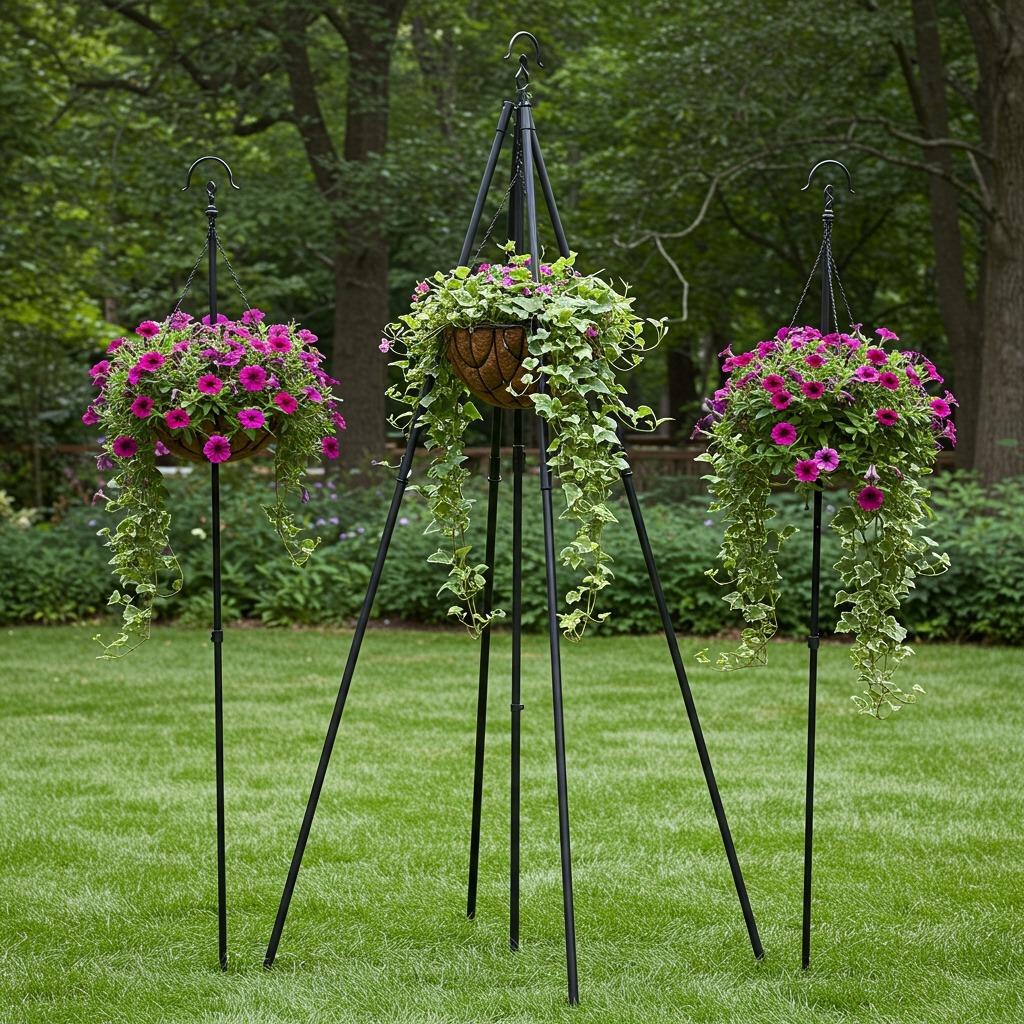
Cluster multiple shepherd’s hooks together to create a vertical garden tower. Hang baskets at staggered heights so plants cascade down in layers without blocking each other.
This works especially well with flowering plants and herbs that benefit from good drainage. The airflow around hanging baskets prevents root rot, and you can rotate baskets to ensure even sun exposure.
Place these towers strategically to define spaces in your garden and nursery ideas or create privacy screens. The vertical height draws the eye upward, making small gardens feel more expansive than they are.
8. Pallet Gardens Against Blank Walls

Wooden shipping pallets transform into rustic vertical planters with minimal effort. Stand a pallet upright, attach landscape fabric to the back, fill the slats with soil, and plant between the boards.
Succulents and herbs work best here since the planting pockets are relatively shallow. Let the pallet cure upright for a week before standing it vertical – this gives roots time to establish so soil doesn’t fall out.
This is genuinely one of the most budget-friendly DIY vertical planters you can make. Pallets are often free from businesses, and the rustic aesthetic fits farmhouse, industrial, or casual garden styles equally well.
9. Window Box Gardens Stacked Vertically
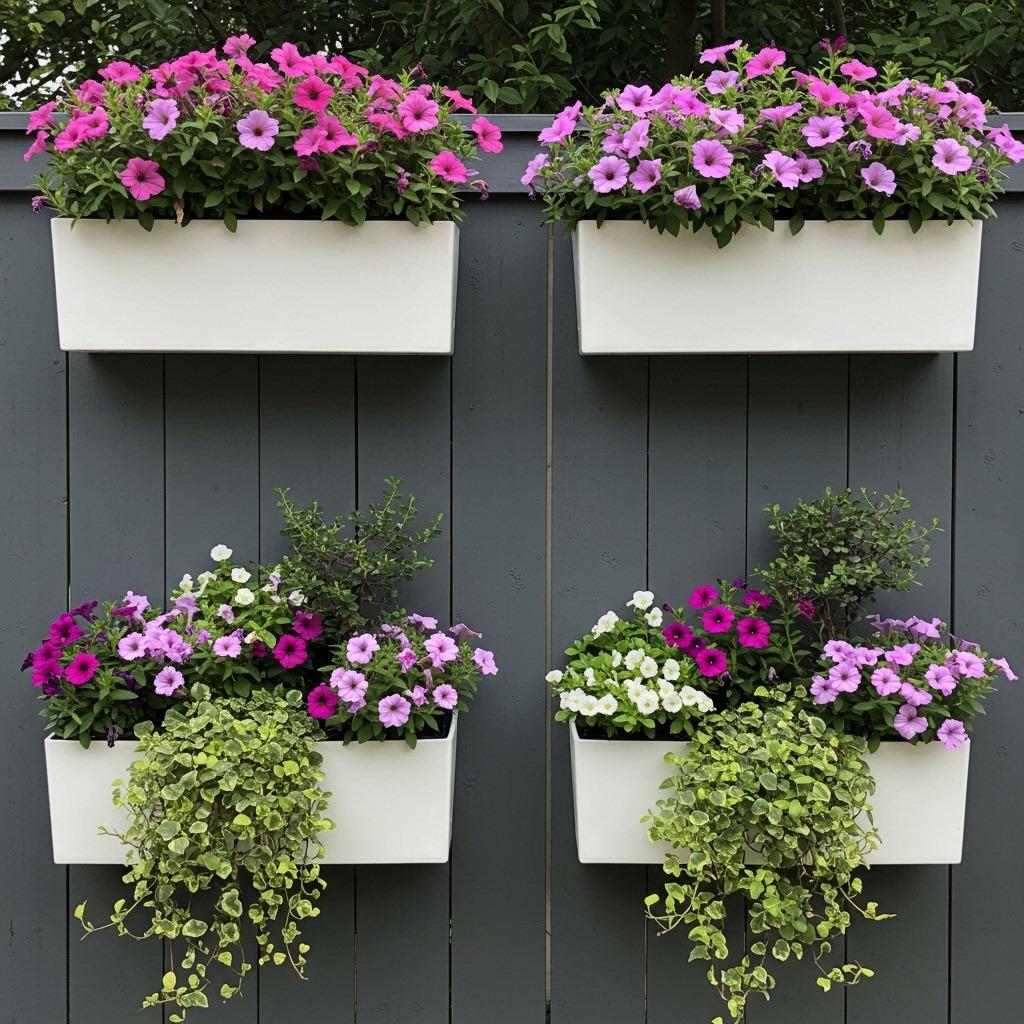
Mount window boxes in a vertical column on a wall or fence to create stacked planting tiers. Use matching boxes for a cohesive look, or mix materials for eclectic charm.
Space them about 12-18 inches apart vertically so plants in upper boxes don’t completely shade those below. This arrangement is perfect for compact flowers, trailing plants, or a combination that creates a cascading effect.
The key is secure mounting – each box gets heavy when soil is wet. Use sturdy brackets rated for the weight, especially if you’re attaching to vinyl siding or drywall. For small space renovation projects, this vertical approach delivers maximum impact with minimal footprint.
10. Tension Rod Plant Hangers for Narrow Spaces

Tension rods installed between walls or posts create instant support for hanging planters. This works brilliantly in narrow walkways, between porch posts, or in awkward gaps where traditional planters won’t fit.
Use S-hooks to hang pots from the rods at varying heights. Swap plants seasonally or rearrange on a whim – nothing’s permanently fixed. The beauty here is complete flexibility without drilling holes everywhere.
Just verify your tension rods can handle the weight. Once soil and water are added, even small pots get surprisingly heavy. For lighter loads, this system works perfectly for air plants, small succulents, or decorative trailing vines.
11. Vertical Garden Towers with Rotating Bases
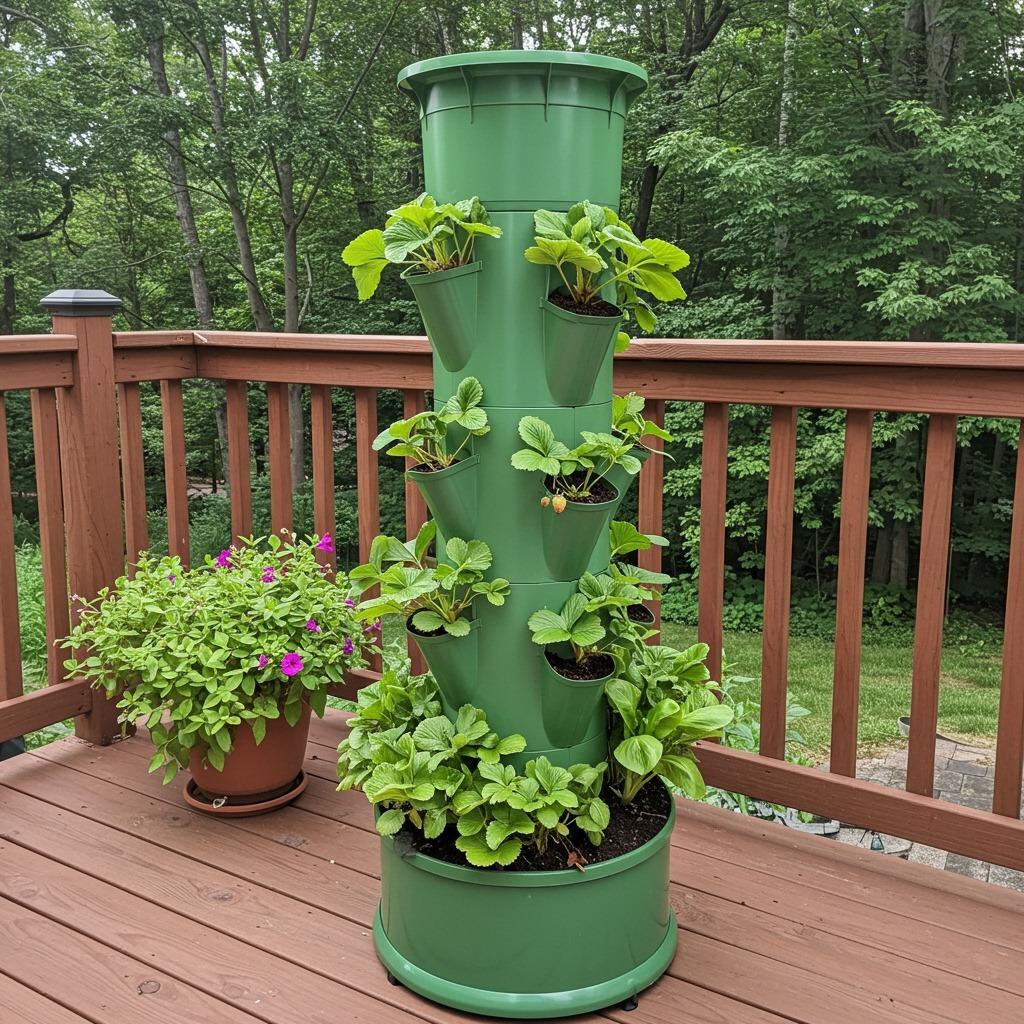
Freestanding tower gardens with rotating bases maximize sun exposure for all plants. These cylindrical structures have planting pockets all around, and you simply spin the tower to give each side adequate light.
They’re ideal for small patios where you can’t control which direction gets sun. Strawberries, lettuces, and herbs thrive in tower gardens, and the compact base takes up less than two square feet of floor space.
Some tower systems include self-watering reservoirs, which is genuinely helpful if you travel or tend to forget watering schedules. It’s one of those living wall tips that actually makes maintenance easier, not harder.
12. Espalier Fruit Trees Along Walls

Espalier is an ancient technique of training fruit trees to grow flat against walls or fences. It looks impossibly elegant while producing actual fruit in minimal space.
Start with dwarf varieties of apples, pears, or citrus specifically bred for espalier. As branches grow, tie them to horizontal wires or a trellis in your desired pattern. The wall behind acts as thermal mass, often extending your growing season.
This technique requires patience – you’re shaping the tree’s growth over years, not weeks. But for small yards where you want fruit trees but lack space, espalier delivers beauty and productivity in the slimmest profile possible.
13. Magnetic Planters on Metal Surfaces

If you have metal railings, gutters, or siding, magnetic planters turn those surfaces into instant gardens. These small pots with strong magnets attach securely without tools or damage.
They’re perfect for renters or anyone hesitant about drilling holes. Use them for small herbs, succulents, or flowering annuals. The modular nature means you can rearrange your garden layout whenever inspiration strikes.
The limitation is size – magnetic planters are necessarily small since larger ones would slide under their own weight. But for adding pops of green to otherwise unused metal surfaces, they’re brilliant little problem-solvers.
14. Vertical Vegetable Gardens Using Grow Bags
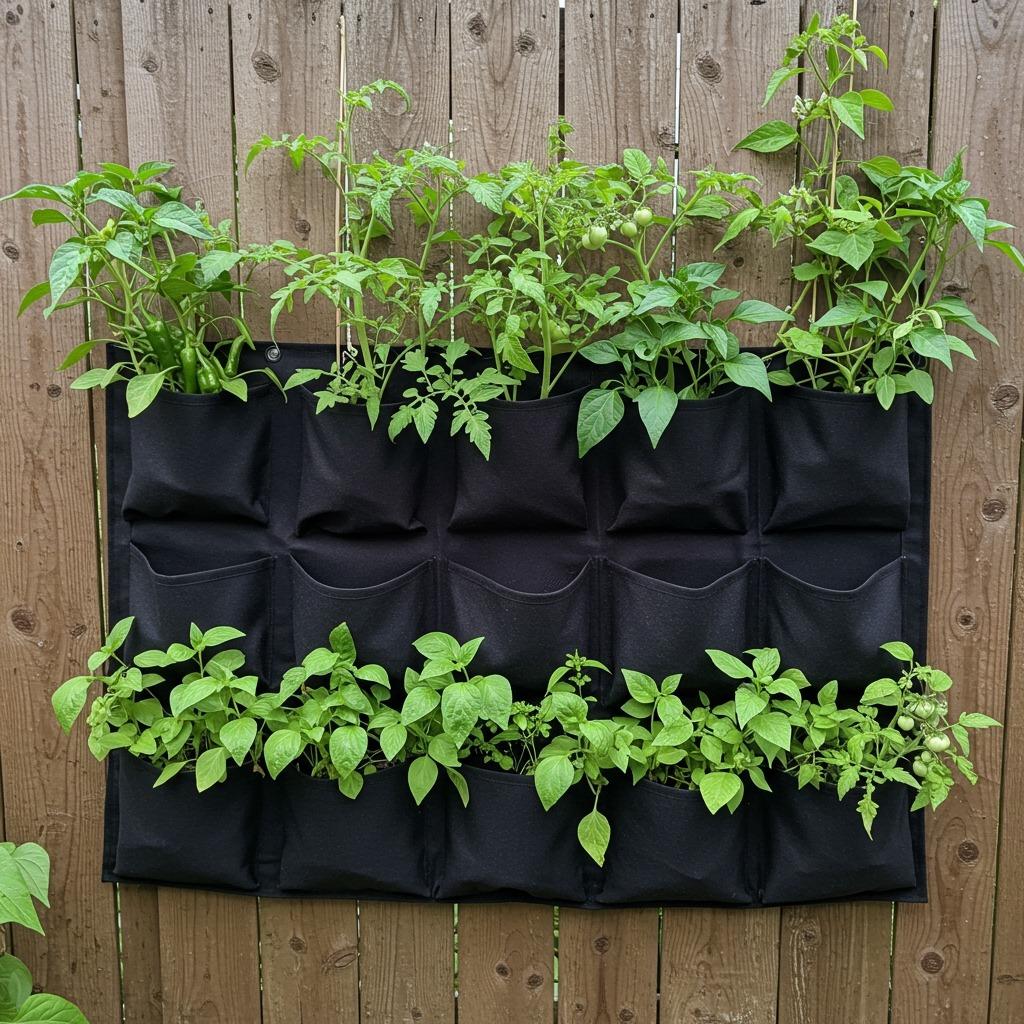
Fabric grow bags designed for vertical hanging create space-efficient vegetable gardens on walls or fences. These bags have multiple pockets – plant tomatoes, peppers, or beans in different sections.
The fabric breathability prevents root circling and overheating common in plastic containers. Hang them where they’ll get six-plus hours of sun daily. As plants grow, they’ll cascade down, creating a productive green wall.
This setup is particularly useful if your ground soil is poor or contaminated. You control the soil quality in each pocket, ensuring optimal growing conditions. Plus, fabric bags are lightweight when empty, making seasonal setup and takedown manageable.
15. Bamboo Frame Vertical Gardens with Wire Mesh
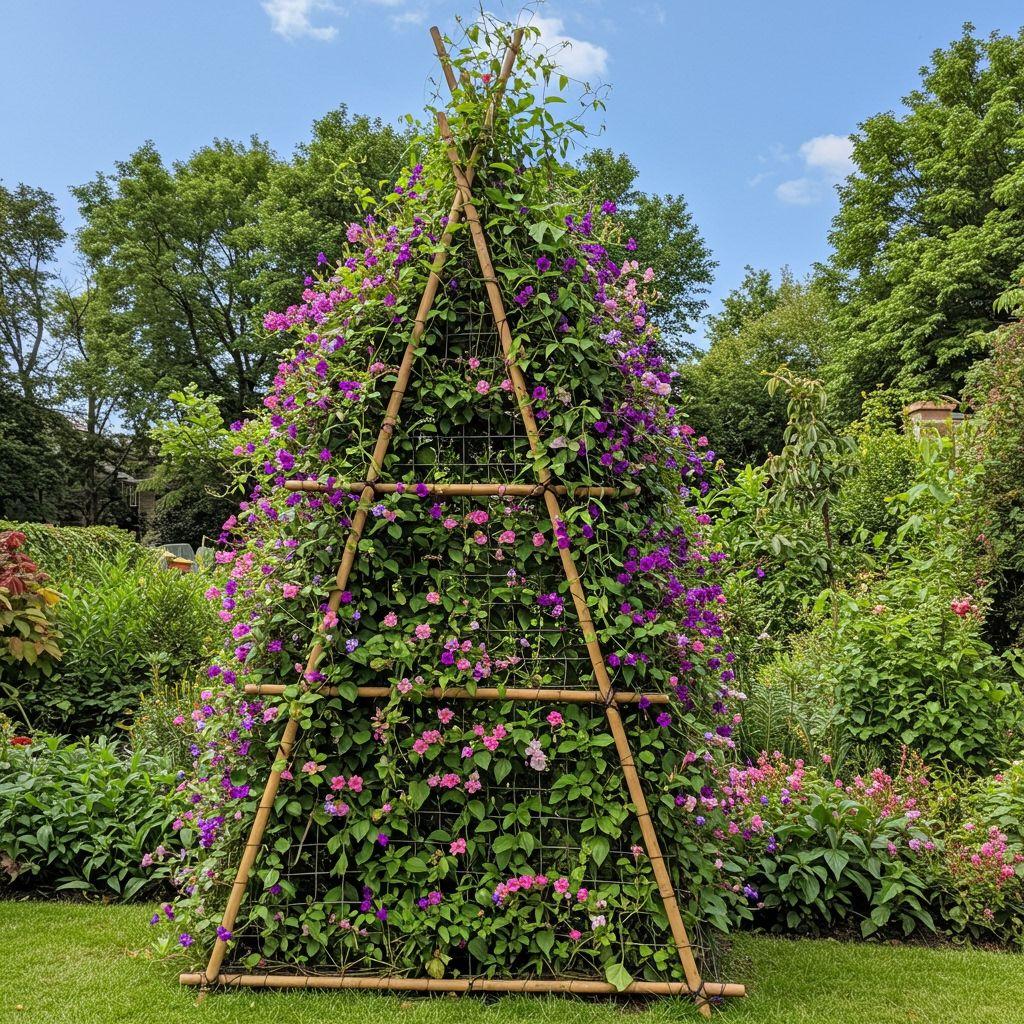
Build a simple frame from bamboo poles and stretch wire mesh or chicken wire across it. Train climbing plants or attach small pots to create a living screen that defines spaces without solid barriers.
This works beautifully as a privacy screen that still allows airflow, or as a garden art piece where plants become the focal point. Morning glories, clematis, or passion vines all cover the structure quickly.
The natural bamboo aesthetic fits almost any garden style, and the materials are inexpensive. If a plant dies or you want to change the look, the frame stays useful – just swap out what’s growing on it.
Small spaces shouldn’t mean giving up on gardening. When you think vertically instead of horizontally, suddenly that narrow balcony or tiny yard has room for herbs, vegetables, flowers, and even fruit trees.
The ideas here range from simple weekend projects to more involved installations, but they all solve the same problem: how to grow more in less space. Pick one that matches your skill level and available area. Start there.
Once you see how much green you can pack into a vertical setup, you’ll start spotting opportunities everywhere. That blank fence? Future strawberry wall. The narrow strip beside your driveway? Perfect for a ladder shelf loaded with flowers.
Your small space garden is just waiting to grow up instead of out. These vertical gardening ideas show you exactly how to make it happen.

